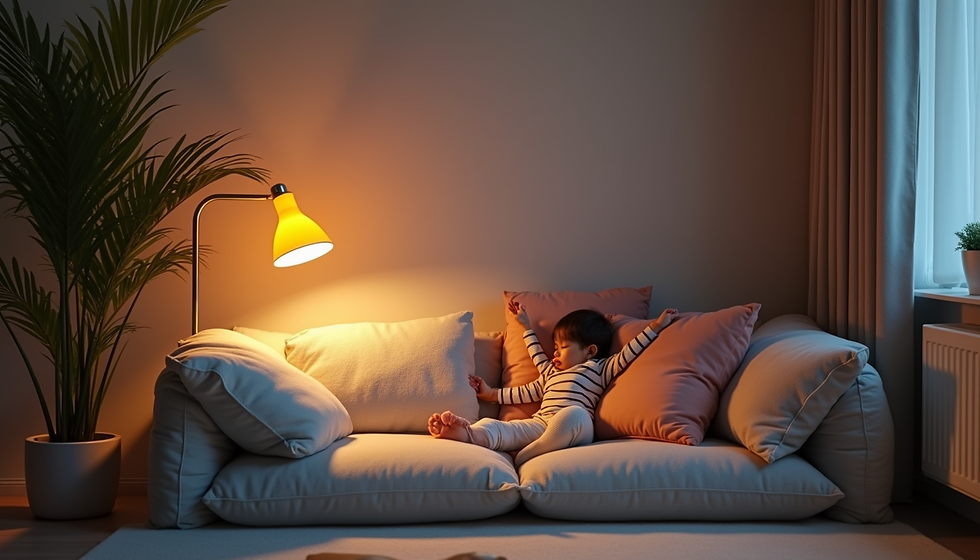Beyond the Tantrums: Why Research Proves PCIT is the Gold Standard for Young Children's Behavior
- Alissa Hansen, MSW, LCSW

- Oct 7
- 4 min read
Updated: Nov 4
If you're a parent or caregiver of a child between the ages of 2 and 7, you know the struggle: the frequent tantrums, the defiance, and the feeling that your child's behavior is simply "out of control." It's an exhausting and often frustrating experience. This challenge isn't limited to just parents; grandparents and other primary caregivers involved in the child's upbringing often experience these difficulties as well.
But what if there was an evidence-based therapy that could not only reduce these challenging behaviors but also fundamentally strengthen your relationship with the child in your care? There is, and it's called Parent-Child Interaction Therapy (PCIT).
PCIT isn't just another parenting class; it's a specialized, short-term treatment that has been proven by decades of rigorous research to be the most effective intervention for young children with disruptive behaviors. And the data speaks for itself.

PCIT: The Evidence-Based Champion
The field of mental health uses a statistical measure called "effect size" (represented by the letter d) to determine how effective a treatment is. An effect size of d=.20 is considered "small," d=.50 is "medium," and d=.80 or higher is a "large" effect—the holy grail of clinical outcomes.
As the image provided by the Oregon Health Authority and WVU Analytics Teams (2019) clearly illustrates, PCIT's effect size soars above other well-known interventions:
PCIT International (Graduated from PCIT): d=1.65
Oregon PCIT (≥4 sessions): d=0.70
The effect size of d=1.65 for children who successfully complete PCIT is a truly remarkable result, firmly establishing it as an extraordinarily large effect intervention. It signifies a profound and significant change in a child's behavior.
To put this into perspective, look at how PCIT compares to other common treatments for childhood behavior problems:
Treatment Modality | Effect Size (d) | Interpretation |
PCIT International | 1.65 | Extraordinarily Large Effect |
Stimulant Medication* | 0.67 | Medium to Large Effect |
CBT* (Cognitive Behavioral Therapy) | 0.66 | Medium to Large Effect |
Incredible Years* | 0.50 | Medium Effect |
Triple P* | 0.35 - 0.57 | Small to Medium Effect |
Child-Centered Play Therapy | 0.34 | Small Effect |
Data on Stimulant Medication, CBT, Incredible Years, and Triple P is based on meta-analysis from worldwide studies, as noted on the slide
PCIT's effect size dramatically surpasses other widely-used modalities, including common parent-training programs, therapy approaches, and even pharmacological interventions. This evidence is why PCIT has received the highest scientific rating of "Well-Supported by Research Evidence" by the California Evidence-Based Clearinghouse for Child Welfare.
How Does PCIT Achieve Such Powerful Results?
PCIT is specifically designed for children aged 2 to 7, a critical period when disruptive behaviors—like defiance, tantrums, and aggression—often emerge and are most malleable to change.
The therapy works by training caregivers in two distinct phases, with a therapist providing real-time coaching via an earpiece while the caregiver and child interact. Crucially, I teach PCIT skills to all essential caregivers involved in the child's life, including parents, grandparents, foster parents, and others, to ensure consistency and widespread positive change in the child's environment.
Phase 1: Child-Directed Interaction (CDI)
This phase is all about relationship enhancement and decreasing troublesome behaviors. Caregivers learn play-therapy skills to foster a warm, nurturing, and secure relationship. The goal is to build the child's self-esteem and attachment to the caregiver. The benefits include:
Increased feelings of security and safety for the child.
Decreased negative behaviors (like whining, anger outbursts, and noncompliance).
A stronger emotional bond between caregiver and child.
Phase 2: Parent-Directed Interaction (PDI)
Once the relationship is strengthened and caregivers have learned ways to decrease negative behaviors simply by focusing on the positive-opposite behavior, caregivers are taught and coached on effective behavior management techniques. This phase focuses on teaching children to mind and comply with adult requests, without resorting to harsh or ineffective discipline. Key outcomes are:
Increased compliance with caregiver requests.
Decreased frequency and severity of aggressive and destructive behavior.
Increased caregiver confidence and decreased stress.
The Takeaway for Families
If you are struggling with the young child in your care, the research is clear: Parent-Child Interaction Therapy is the most powerful and effective tool available. By including all primary caregivers, this modality ensures consistent discipline and positive reinforcement across the child's life, which is a proven path to not only reduce difficult behaviors but to fundamentally improve the quality of your family life.
When choosing a treatment, families deserve to know they are investing in what works. The impressive effect size of PCIT isn't just a number; it represents real-world change for caregivers who are feeling overwhelmed, giving them the confidence and skills to build a stronger, happier home.
Additional Strategies for Supporting Young Children
Understanding and supporting young children can be challenging. Here are some strategies that can help you navigate this journey:
Create a Routine
Children thrive on predictability. Establishing a daily routine can provide a sense of security. It helps children know what to expect, reducing anxiety and behavioral issues.
Encourage Open Communication
Foster an environment where children feel safe expressing their feelings. Use age-appropriate language to help them articulate their emotions. This practice can enhance their emotional intelligence and strengthen your bond.
Practice Self-Care
As caregivers, it's essential to prioritize your well-being. Engage in activities that rejuvenate you. Whether it’s a short walk, reading, or meditation, taking care of yourself enables you to be more present and patient with your child.
Seek Support
Don’t hesitate to reach out for help. Whether it’s from family, friends, or professionals, having a support system can make a significant difference. Sharing experiences with others can provide new insights and coping strategies.
Want to learn more? Use my website's inquiry page to contact me.
_edite.jpg)



Comments